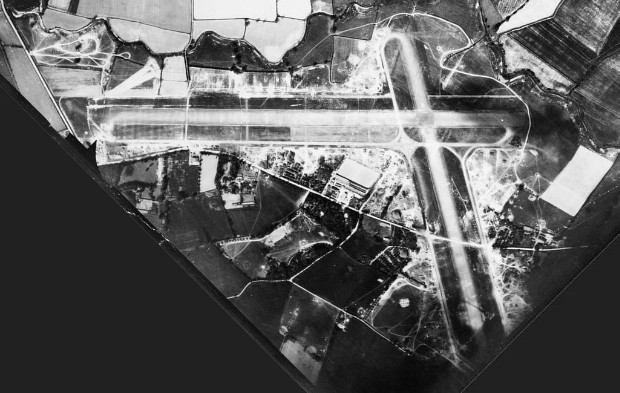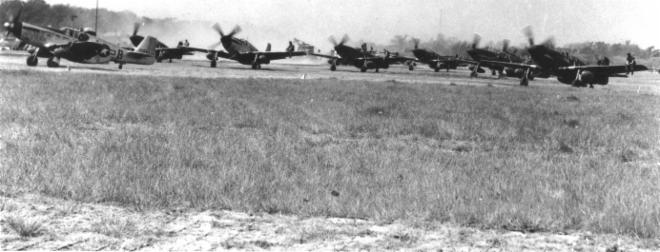The origins of the airstrip located at Shenley Farm and Estate date back to 1911. It's use was strictly recreational but in 1914 it came to the attention of The Royal Flying Corps who considered it a suitable site for a flying school and it was duly requisitioned. It was released at the end of The Great War and civilian flying began again. In 1927 there was a change of ownership when Mr.Edward J. Freeman (great, great Grandfather of the current owner) purchased the freehold of Shenley Farm at an auction in The Royal Star Hotel, Maidstone.
Second World War
Following the outbreak of the Second World War, it was not long before the airstrip came to the attention of The Airfields Board and in 1943 the site was again requisitioned by the military. The original plan, following upgrading, was to use what had now become RAF Lashenden, as a light bomber base but this was abandoned in favour of plans to create a cluster of small airfields in the South East to support the planned invasion of occupied Europe in 1944. They became known as Advanced Landing Grounds and could be found at Ashford, High Halden, Kingsnorth, Staplehurst, Woodchurch, Egerton (confusingly named RAF Headcorn !) and Lashenden.
 Lashenden Airfield 22nd May 1944
Lashenden Airfield 22nd May 1944
Two runways were created at Lashenden ; West/ North/ West of 4,800ft. and North/South of 4,200ft. The grass runways were overlaid with prefabricated steel mesh known as Somerfeld Tracking which rendered them fit for use in all but the most inclement conditions. Officers would be billeted at Shenley House whilst other ranks found themselves under canvas.
Royal Canadian Air Force
Supermarine Spitfire IX TB634 of 421 Squadron RCAF
The first occupants flew in on the 7th August 1943 in the shape of No’s 403 “Wolf” and 421 “Red Indian” Squadrons of the Royal Canadian Air Force. The Squadrons formed No.127 Wing of the 2nd Tactical Air Force and they operated the Mark 9 Spitfire under the command of the legendary Wing Commander Johnnie Johnson. Their stay at Lashenden was short lived and they moved on to RAF Headcorn (Egerton) on the 20th August 1943.
No. 127 Wing RCAF
United States Air Force
During the ensuing eight months Lashenden underwent further upgrading that included strengthening the runways and provision of hard stands for parked aircraft. On the 13th April 1944, the airfield became the Headquarters of the 100th Fighter Wing of the 19th Tactical Air Command of the United States 9th Air Force. At the same time the base name was changed from Lashenden to Station 410.
North American P51B Mustang 42-103798 of the 355th Fighter Squadron
On the 17th April the 353rd, 355th and 356th Fighter Squadrons of the 354th Fighter Group flew in their North American P-51B Mustangs from the previous base at Boxley in Essex. The Commanding Officer was Lt.Col. George R.Bickell (affectionately known as “Uncle” by the pilots). Whilst at Station 411, the 354th were engaged in numerous classes of operation from bomber escorts to ground attack missions. Justifying the original concept of the Advanced Landing Grounds, the 354th undertook missions on D-Day escorting C-47’s towing gliders into the invasion area of Normandy. With the breakout from the beaches completed, the 354th were ordered to prepare for movement to a new base at Criqueville in Northern France. This was successfully completed on the 22nd June 1944.
Chow Time Airmen line up for the meal in the orchards around Shenley farm
Home Comforts on the airfield, P51B Mustang Steve's Cozy Dive
43-6369 GQ-U in the background

Aircraft Left Bill Kings GQ-B 42-106434“Atlanta Peach”,far Right Bill Perkins “Angel From Hell”
& Frank O’Connors “Verna Q”
General George “Blood & Guts” Patton, General Weyland & Colonel Bickell at the airfield on 27th May 1944.
Post War to Present
The end of the 1950’s saw Chris Freeman take over control and his wife, who was also a qualified pilot, ensured that civilian flying would once again be a feature of the aerodrome. During the 1960’s parachuting commenced with a number of club’s becoming resident. In 1970, Jack Matthews opened the Lashenden Air Warfare Museum and more recently it has been able to expand following the opening of a new Exhibition Hall. More aviation related business arrived during the 1990’s as operations at the airfield grew considerably and it became necessary to construct and open a new hangar in 2011. Links with its military past saw the airfield change its name to Lashenden – Headcorn. Three years later saw the arrival of Aero Legends who immediately commenced offering flight experiences in a pair of converted, twin seat Spitfires supported by a Harvard, Tiger Moth and Devon. Other aircraft, including two C47 Dakota’s have joined the fleet. Continued growth of private flying at the airfield has seen work commence on a second hangar to satisfy the demand and help secure the future.